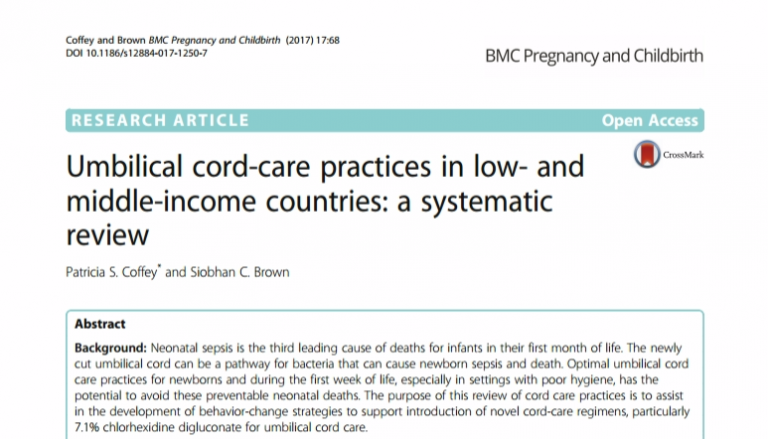Patricia Coffey, coauthor of Umbilical cord-care practices in low- and middle-income countries: a systematic review, says that neonatal sepsis is responsible for more than 15 percent of neonatal deaths globally and is the third leading cause of death during the first month of life. A newly cut umbilical cord can be a pathway for bacteria that can cause newborn sepsis and death. Optimal umbilical cord care practices, including application of chlorhexidine gel, have the potential to prevent neonatal deaths, while harmful traditional cord-care practices are often cited as a public health concern.
Coffey facilitates the Chlorhexidine Working Group, a group of donors, implementers, and private-sector companies that has been meeting regularly for the past several years to advance the use and scale-up of 7.1% chlorhexidine gluconate to prevent infection of the umbilical cord in appropriate settings. She said she was aware of some formative research studies that documented use of traditional cord care practices in low-resource settings, and that the working group often discusses traditional cord care practices, especially harmful ones. “So we wondered, are they that common? We wanted to get a better understanding of what practices were, how many were potentially harmful, and how these practices were relevant to the introduction of 7.1% chlorhexidine gluconate for umbilical cord care,” she said.
Coffey and coauthor Siobhan Brown reviewed 46 articles from 15 countries. They found clusters of studies in countries like Zambia and Uganda where much is known about cord care practices. But they think there is much unpublished data and would like to encourage others to publish.
Coffey said she learned there is a strong tradition in almost all countries they studied of people wanting to do something with the cord: “They say they want the cord wound to heal, to heal faster, and the cord to fall off more quickly.” Some practices, she said, were not surprising, for example, applying toothpaste, ash, or burnt leaves.
One example that stood out was python oil, and another was a similar substance from two very different geographic areas: rotten tree powder in Turkey and powder from an old door in Tanzania. Some substances would be considered potentially harmful, for example, dung – a few countries reported use of chicken, cow, and lizard dung. Another practice was washing the umbilical cord with water used to wash a woman’s genitalia. “Some of these practices may be harmful, while others may be less so or possibly not harmful. Fortunately such practices seem to be increasingly less common,” Coffey said.
Coffey noted “that we have a lot of information on cord care practices in a few countries but not a complete picture across low- and middle-income countries.”
“Another surprise,” she said, “was our tendency to think families will take care of a facility-born baby differently, but it seems the same things happen to babies no matter where they’re born when it comes to umbilical cord care.” Coffey suggested practitioners need to think about that as they introduce new practices such as the application of chlorhexidine.
Coffey said the study helped her realize that when introducing products such as chlorhexidine for cord care, “we need to pay more attention to existing practices. It is unrealistic to expect families to abandon current practices immediately or to swap out practices that are done more than once in a day for something that is very different.”
She said that good behavior change communication, with follow-up to observe behaviors and support the transition, could help align current and new practices. “Families generally do cord care for a number of days, not just once, so there’s potential for a substitution of existing practice with the new multiple-day regimen.”
 Dr. Patricia S. Coffey is a program advisor and leader of the Health Technologies for Women and Children group within the PATH Devices and Tools Global Program. Dr. Coffey has more than 25 years of experience in product development and implementation research of newborn, maternal, and reproductive health technologies for low-resource settings.
Dr. Patricia S. Coffey is a program advisor and leader of the Health Technologies for Women and Children group within the PATH Devices and Tools Global Program. Dr. Coffey has more than 25 years of experience in product development and implementation research of newborn, maternal, and reproductive health technologies for low-resource settings.
